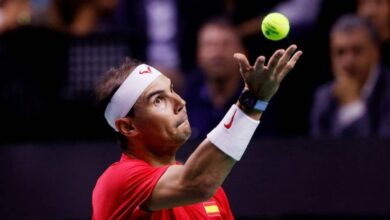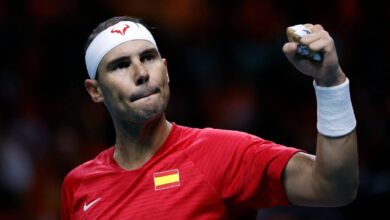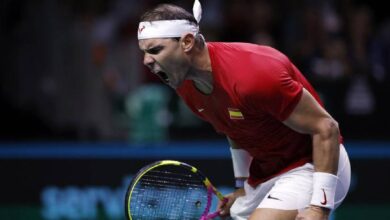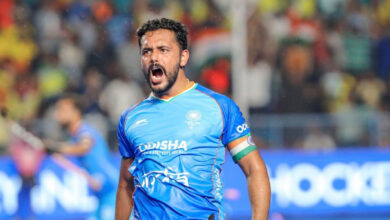Reboot of game and ambition needed for PV Sindhu, who wobbles to tame defeat to Nozomi Okuhara | Badminton News

Memories of past glory are casting a long, debilitating shadow on PV Sindhu’s present game, which is in urgent need of rejigging upgrades and one real reboot, but is instead sloping down a spiral.
It’s been 10 long, tiring years of fighting at the World Championships, of taking out the fancied names in giant kills, since her 2013 bronze. Add to that the two Olympic medals. But someone would need to shake the 28-year-old awake and drill into her conscience that she is built to go upto 32-33 and is capable of multiple World titles, not just the one at Basel. Fading out gently, passively following Nozomi Okuhara’s lead in the pace and cadence of rallies, offering little initiative of her own, just reacting, is not how the World Championships saga ought to end in the storied Sindhu vs Okuhara rivalry. The inspiration to reboot and rediscover was standing right across the net, rather scrambling like crazy from one corner to another, getting every shuttle back to string together points.
Noone knows if the 2019 gold just completely satiated Sindhu’s appetite for an almighty fight. But there was no sting or precision in her attack, neither the doggedness in playing that one extra accurate shot in her defense, that could’ve pulled her out of the 21-14, 21-14 rut of Tuesday against Okuhara. Sindhu looked the farthest she will ever be from the 21-7, 21-7 scoreline and mentality of the Basel final where she won gold, instead exiting tamely from her first match at Copenhagen.
As positively reinforcing as it might be for her morale, reminiscing about the seventh anniversary of her Olympic silver from 2016 on the eve of a tough World Championship campaign in 2023 pointed to a mind and body stuck somewhere in the past. Both Okuhara and the Indian were coming into the Round of 32 of the Copenhagen World’s on the back of torrid lapse of form in the last one year. But only the Japanese looked ready to forget all about her 2017 World title, turn the page, and literally put her head down and lunge and retrieve tirelessly to reprise that winninger pugnacious game, to start all over again in pursuit of a fresh goal.
The Japanese from Nagano was World No 1 in 2019 and had since spent entire seasons tethered and limited injury. But on Tuesday on her return this season, Okuhara came prepared to put in the mileage on court. It remains astounding how the 5’2 player, much like Yamaguchi, manages staggering court coverage and plays the high shuttle game of jumping and arching back to strike the birds way behind her head, point after punishing point. Still at 28. Not that Sindhu was hitting with much power, but in that Plan A / no other plan monotone that she did dish out, Sindhu was making Okuhara chase the shuttle to diagonal corners and on either flanks at the net. That the Japanese was prepared to put in this hard work frustrated Sindhu no end, and she invariably conceded errors.
Okuhara began like always – talking to herself before entering the court, a slight bow of respect, and then the full stretch lunge working up the preps for what was to follow. Sindhu started the match with a cross drop winner, but subsequently her angled shots lacked precision as they got dumped into the net. Okuhara has select outright kill shots, very few of them, but she could make do, because neither was Sindhu attacking with any power or precision from across the net. High serves, another Okuhara staple, alongwith high tosses totally neutralised Sindhu, and their persence alongside the Japanese shuttler’s ability to bend low in stretch defense saw her dominate the long rallies as early as 4-3 in the opener.
The one time Sindhu famously used her height to strike the shuttle real tall and fashioned her jump smashes into sharp kills was in the Rio Games semifinal. But Okuhara has since then moved to hitting those high tosses and unsmashable dizzying lifts, giving it back to Sindhu and tiring out her long limbs on the aerials. Since the Indian couldn’t find gaps on Tuesday within court confines with Okuhara defending heroically, she was forced to go for the lines, where her radar was woefully out of order. Sindhu’s own low pickups would land in the net and her pushes strayed long and wide as she struggled to find any length from midcourt. All Okuhara had to do was prolong the rally, get her own cross drops on the lines, and a Sindhu error would inevitably fetch up from a defeated wild swing of the racquet as she took the opener 21-14.
Sindhu‘s only enterprise was a serve variation at the start of the second which seemed to shake Okuhara a tad as she fell back 0-9. But the Japanese soon came to grips with the Indian’s trick and once she had a read on that, she would restore momentum in her favour going into the break just two behind at 9-11. Slow courts demanded that Sindhu powered through, as she once used to and maintained the rigour in defense, both of which she was found wanting in. Her go-to when the match started slipping from her was injecting half hearted pace into the shots, but she would give up on that too, as Okuhara remained resolute.Most Read
1
Chess World Cup 2023 Final Live Updates: Praggnanandhaa vs Magnus Carlsen game 1 ends in draw; Caruana loses
2
Gadar 2 box office collection Day 11: Sunny Deol film surpasses Aamir Khan’s Dangal, earns Rs 388.60 cr
See More
Whatever confidence the 9-0 lead might’ve generated evaporated in a jiffy, and before a decider even drifted on the horizon, it turned into a mirage, as Sindhu fell back into erring in long rallies. A significant reason why the 2017 final is labelled a classic is that Sindhu matched Okuhara in retrieving some impossible shuttles. On the slow courts of Copenhagen, she just didn’t look keen to fight it out in the rally like at Glasgow, and stabbed at the shuttle looking for impatient kills, blinking first all too often. A flat low crosscourt winner at 11-9 was the last of her ripostes, but Okuhara took 6 points from 9-12 down to reach 15-12, and like has been the case past two seasons when Sindhu loses the lead these days, she gets deflated soon enough.
Sindhu added some revs on the shoulder at 13-15 and was immediately rewarded with a point, indicating how predictable pace had seen her come undone. But next point, Okuhara was made to work hard, chase the shuttle around the court and when she outran Sindhu, the Indian’s back was broken. At 14-16 Sindhu would finally smash the high serve, but each time the Japanese prevailed in a rally, Sindhu would slump her shoulders and gift errors. Both sets ended with tame attempts to keep the smashes in, as Sindhu sprayed them wide on an open half of the court with Okuhara out of position.
Even a 9-0 cushion wasn’t enough to press the advantage and force a decider. There was no semblance of either the 2017 nor the 2019 finals against Okuhara in Sindhu of 2023. Opposite her though, Okuhara seemed to have neatly folded the memories of them both away, and came equipped to fight a fresh battle. She would grin and tell the camera: “Thank-you, supporting me!” It left you with a nagging feeling that only one half of a glorious comeback was complete.







